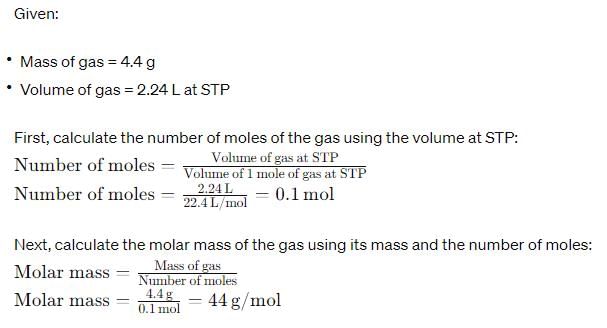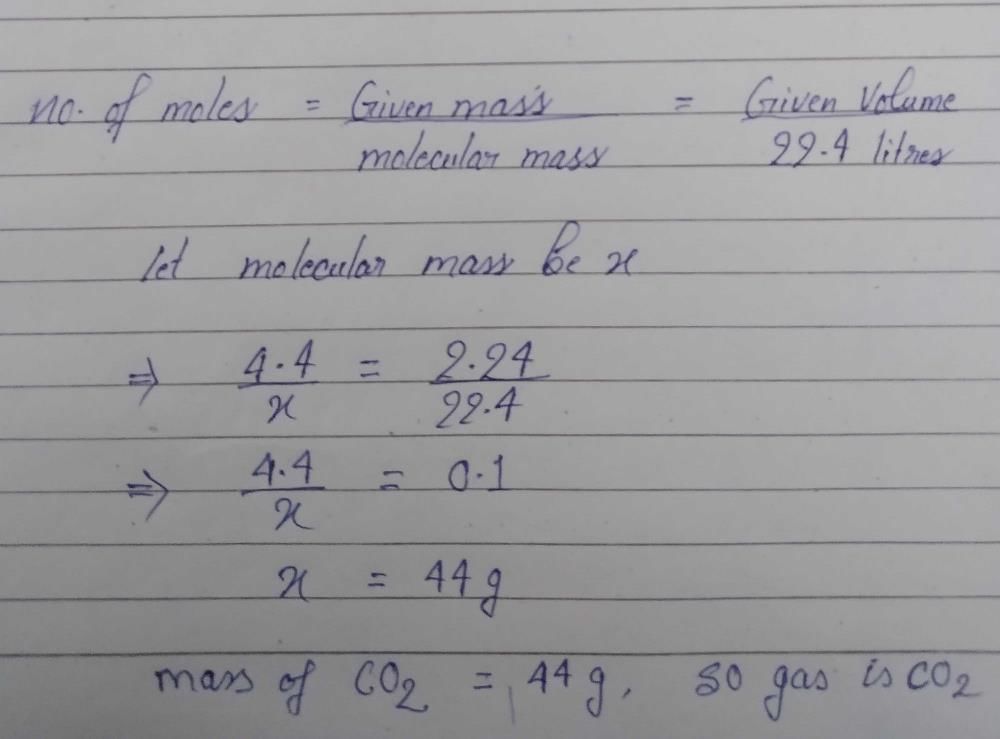NEET Exam > NEET Questions > 4.4 g of an unknown gas occupies 2.24 litres ...
Start Learning for Free
4.4 g of an unknown gas occupies 2.24 litres of volume at standard temperature and pressure. The gas may be
- a)SO₂
- b)CO
- c)O₂
- d)CO₂
Correct answer is option 'D'. Can you explain this answer?
Verified Answer
4.4 g of an unknown gas occupies 2.24 litres of volume at standard tem...

so CO2 is correct answer
Most Upvoted Answer
4.4 g of an unknown gas occupies 2.24 litres of volume at standard tem...

Free Test
FREE
| Start Free Test |
Community Answer
4.4 g of an unknown gas occupies 2.24 litres of volume at standard tem...
Given:
Mass of gas = 4.4 g
Volume of gas = 2.24 L
Gas at STP
We can use the ideal gas law to determine the number of moles of the gas present:
PV = nRT
where P is the pressure, V is the volume, n is the number of moles, R is the gas constant, and T is the temperature.
At STP, the pressure is 1 atm and the temperature is 273 K. Therefore, we can write:
n = PV/RT = (1 atm)(2.24 L)/(0.0821 L·atm/mol·K)(273 K) = 0.092 mol
Next, we can use the molar mass of each gas to determine which gas has a mass of 4.4 g and a mole number of 0.092 mol:
a) SO₂: Molar mass = 64.06 g/mol. Mass of 0.092 mol = 5.89 g, which is greater than the given mass of 4.4 g. Therefore, SO₂ cannot be the gas.
b) CO: Molar mass = 28.01 g/mol. Mass of 0.092 mol = 2.57 g, which is less than the given mass of 4.4 g. Therefore, CO cannot be the gas.
c) O₂: Molar mass = 32.00 g/mol. Mass of 0.092 mol = 2.94 g, which is less than the given mass of 4.4 g. Therefore, O₂ cannot be the gas.
d) CO₂: Molar mass = 44.01 g/mol. Mass of 0.092 mol = 4.04 g, which is very close to the given mass of 4.4 g. Therefore, CO₂ is the gas.
Hence, the correct answer is option 'D' (CO₂).
Mass of gas = 4.4 g
Volume of gas = 2.24 L
Gas at STP
We can use the ideal gas law to determine the number of moles of the gas present:
PV = nRT
where P is the pressure, V is the volume, n is the number of moles, R is the gas constant, and T is the temperature.
At STP, the pressure is 1 atm and the temperature is 273 K. Therefore, we can write:
n = PV/RT = (1 atm)(2.24 L)/(0.0821 L·atm/mol·K)(273 K) = 0.092 mol
Next, we can use the molar mass of each gas to determine which gas has a mass of 4.4 g and a mole number of 0.092 mol:
a) SO₂: Molar mass = 64.06 g/mol. Mass of 0.092 mol = 5.89 g, which is greater than the given mass of 4.4 g. Therefore, SO₂ cannot be the gas.
b) CO: Molar mass = 28.01 g/mol. Mass of 0.092 mol = 2.57 g, which is less than the given mass of 4.4 g. Therefore, CO cannot be the gas.
c) O₂: Molar mass = 32.00 g/mol. Mass of 0.092 mol = 2.94 g, which is less than the given mass of 4.4 g. Therefore, O₂ cannot be the gas.
d) CO₂: Molar mass = 44.01 g/mol. Mass of 0.092 mol = 4.04 g, which is very close to the given mass of 4.4 g. Therefore, CO₂ is the gas.
Hence, the correct answer is option 'D' (CO₂).

|
Explore Courses for NEET exam
|

|
Question Description
4.4 g of an unknown gas occupies 2.24 litres of volume at standard temperature and pressure. The gas may bea)SOb)COc)Od)COCorrect answer is option 'D'. Can you explain this answer? for NEET 2025 is part of NEET preparation. The Question and answers have been prepared according to the NEET exam syllabus. Information about 4.4 g of an unknown gas occupies 2.24 litres of volume at standard temperature and pressure. The gas may bea)SOb)COc)Od)COCorrect answer is option 'D'. Can you explain this answer? covers all topics & solutions for NEET 2025 Exam. Find important definitions, questions, meanings, examples, exercises and tests below for 4.4 g of an unknown gas occupies 2.24 litres of volume at standard temperature and pressure. The gas may bea)SOb)COc)Od)COCorrect answer is option 'D'. Can you explain this answer?.
4.4 g of an unknown gas occupies 2.24 litres of volume at standard temperature and pressure. The gas may bea)SOb)COc)Od)COCorrect answer is option 'D'. Can you explain this answer? for NEET 2025 is part of NEET preparation. The Question and answers have been prepared according to the NEET exam syllabus. Information about 4.4 g of an unknown gas occupies 2.24 litres of volume at standard temperature and pressure. The gas may bea)SOb)COc)Od)COCorrect answer is option 'D'. Can you explain this answer? covers all topics & solutions for NEET 2025 Exam. Find important definitions, questions, meanings, examples, exercises and tests below for 4.4 g of an unknown gas occupies 2.24 litres of volume at standard temperature and pressure. The gas may bea)SOb)COc)Od)COCorrect answer is option 'D'. Can you explain this answer?.
Solutions for 4.4 g of an unknown gas occupies 2.24 litres of volume at standard temperature and pressure. The gas may bea)SOb)COc)Od)COCorrect answer is option 'D'. Can you explain this answer? in English & in Hindi are available as part of our courses for NEET.
Download more important topics, notes, lectures and mock test series for NEET Exam by signing up for free.
Here you can find the meaning of 4.4 g of an unknown gas occupies 2.24 litres of volume at standard temperature and pressure. The gas may bea)SOb)COc)Od)COCorrect answer is option 'D'. Can you explain this answer? defined & explained in the simplest way possible. Besides giving the explanation of
4.4 g of an unknown gas occupies 2.24 litres of volume at standard temperature and pressure. The gas may bea)SOb)COc)Od)COCorrect answer is option 'D'. Can you explain this answer?, a detailed solution for 4.4 g of an unknown gas occupies 2.24 litres of volume at standard temperature and pressure. The gas may bea)SOb)COc)Od)COCorrect answer is option 'D'. Can you explain this answer? has been provided alongside types of 4.4 g of an unknown gas occupies 2.24 litres of volume at standard temperature and pressure. The gas may bea)SOb)COc)Od)COCorrect answer is option 'D'. Can you explain this answer? theory, EduRev gives you an
ample number of questions to practice 4.4 g of an unknown gas occupies 2.24 litres of volume at standard temperature and pressure. The gas may bea)SOb)COc)Od)COCorrect answer is option 'D'. Can you explain this answer? tests, examples and also practice NEET tests.

|
Explore Courses for NEET exam
|

|
Signup for Free!
Signup to see your scores go up within 7 days! Learn & Practice with 1000+ FREE Notes, Videos & Tests.



















